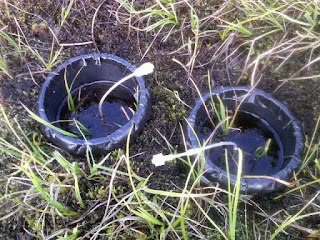The NGEE Arctic project has many objectives as we deliver
a process-rich model of terrestrial ecosystems for inclusion into Earth System
Models. While that is our primary focus, we are also committed to providing a
resource that other scientists can use. Together, we can pursue similar goals in
the Arctic.
Ken Williams (LBNL) is one such person who, along with
Derek Lovley (UMass), approached our team earlier this spring with an idea which would utilize our field sites in Barrow. Having discussed
their ideas on the telephone, we then asked that they provide a written scope of
research that described what they wanted to do, why, how it would complement
the NGEE Arctic project, and a description of proposed measurements. We also
asked for a list of potential safety considerations. Once we had completed
discussions and approved his work plan, Ken began his preparations for the trip
to Alaska.
This week, Ken is prepared to install graphite
anode-cathode sensors to monitor microbial metabolism at locations along the
Site 0 transect. His boxes of equipment eventually arrived and we spent the
morning unpacking and sorting various probes, electronics, data loggers, and
equipment housings. Ken is going to place sensors at three locations along the
transect; low-center, high-center, and flat-center (or transitional polygons).
These three types of ice-wedge polygons have distinct hydrology and
geochemistry. Ken reasons that such differences will be reflected in the
timing or magnitude of microbial metabolism. Within each of the polygon types,
Ken will be monitoring trough, rim, and center locations.
Ken and I spent the afternoon transporting all his
equipment to the field, including three deep-cycle marine batteries. The use of
wheelbarrows, at least along the trail mat and wooden boardwalk, was a pretty
effective way of moving items from the truck to the field shed and ultimately
out to an area adjacent to the transect. From there it was a matter of carrying
items carefully across the tundra. This was no easy task, but one we
carefully completed in a few hours. It was then up to Ken to install electrodes, wire
them appropriately to data loggers, and collect other ancillary data like soil
temperature, thaw depth, etc.
I'll post additional information on Ken's activities in the
future. More information about the research of Ken, Derek, and their colleagues
can be found in several recent publications. The one that I am most familiar
with is the Williams et al. article published in 2010 in the journal,
Environmental Science and Technology.
Finally, we welcome other potential collaborators to
contact us directly or through the collaborators page at our NGEE Arctic web
site. We can also provide (with discussion and agreement across our team)
water, plant, and soil samples...assuming all required permits are completed and
in place before distribution of materials. We'd like to hear from you!











































